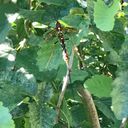Megarhyssa nortoni nortoni
Classification
- Phylum: Arthropoda
- Subphylum: Hexapoda
- Class: Insecta
- Order: Hymenoptera
- Superfamily: Ichneumonoidea
- Family: Ichneumonidae
- Subfamily: Rhyssinae
- Genus: Megarhyssa
- Species: nortoni
- Subspecies: nortoni
Pronunciation
How to pronounce Megarhyssa nortoni nortoni: //ˌmɛɡəˈrɪsə ˈnɔrtəni ˈnɔrtəni//
These audio files are automatically generated. While they are not always 100% accurate, they are a good starting point.
Images





Summary
Megarhyssa nortoni nortoni is a subspecies of giant ichneumon wasps known for its long ovipositor and role as a parasitoid of wood-boring larvae. They are identified by their large size, coloration variations, and specific behaviors related to reproduction and host finding.
Physical Characteristics
Megarhyssa male adults reach body lengths of 2.3 to 3.8 cm (0.9 to 1.6 inches), while female adults measure from 3.5 to 7.5 cm (1.5 to 3 inches). Females possess an extremely slender ovipositor that is much longer than the body, ranging from 5 to 10 cm (2 to 4 inches). Variation in coloration occurs, including dark brown, bluish black, reddish brown, and bright yellow.
Identification Tips
Females can be distinguished by their long ovipositor, which is longer than their body. Males exhibit different body lengths and have less pronounced coloration than females. M. atrata features a bright yellow head and black body, making it easily distinguishable from other sympatric species that have yellow and brown striped patterns.
Habitat
Megarhyssa species inhabit deciduous forests and are widespread across the United States and Canada, with some species found in the Paleartic region. M. nortoni has also been introduced to South Africa, Australia, and New Zealand.
Distribution
Globally distributed, with species occurring in the United States, Canada, and introduced populations in South Africa, Australia, and New Zealand.
Diet
Adults mostly do not feed but may feed on water droplets containing nectar. The larvae are parasitic, feeding on the developing larvae of their wood-boring host.
Life Cycle
The female Megarhyssa locates a larva of Tremex columba in the bark of a tree, lays an egg on or near it, and the larva feeds on the host, pupating under the bark and emerging as an adult the following year.
Reproduction
Female Megarhyssa locate hosts through the bark and utilize their ovipositor to lay eggs near or on the larva they intend to parasitize. Males may mate with females before they emerge using their sensory organs to detect their presence.
Ecosystem Role
Megarhyssa plays a role as a parasitoid, controlling populations of wood-boring larvae, which can affect forest health.
Evolution
M. nortoni females perform longer flights than males, as they search for new habitats and locate hosts, suggesting a role in habitat redistribution and host searching behavior.
Misconceptions
The ovipositor can be mistaken for a stinger; however, it is used for laying eggs, not for stinging.
Tags
- Megarhyssa
- Ichneumonidae
- parasitoid
- Hymenoptera
- insects